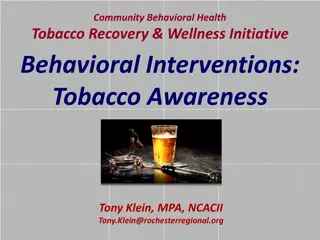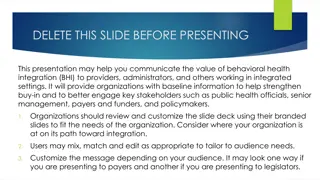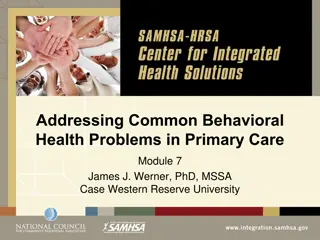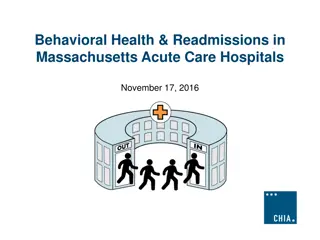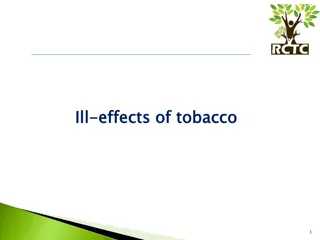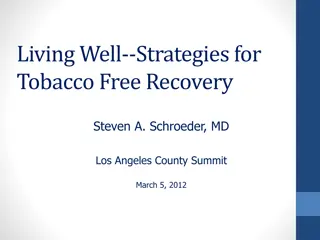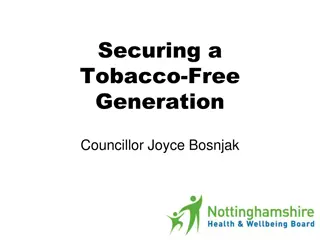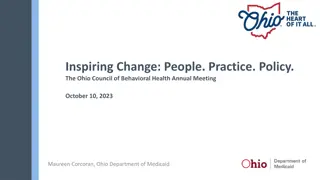Addressing Tobacco Use in Behavioral Health Settings: Policy & Practical Approaches
This presentation, sponsored by the Maryland Behavioral Health Administration, discusses tobacco use in behavioral health treatment settings, focusing on policy implementation and practical approaches. The content covers statistics on smoking prevalence in Maryland, cessation rates, and ways to support those trying to quit smoking. Participants are encouraged to utilize resources like the MDQuit program and free counseling services to promote smoking cessation among adults and youth.
Download Presentation

Please find below an Image/Link to download the presentation.
The content on the website is provided AS IS for your information and personal use only. It may not be sold, licensed, or shared on other websites without obtaining consent from the author. Download presentation by click this link. If you encounter any issues during the download, it is possible that the publisher has removed the file from their server.
E N D
Presentation Transcript
Addressing Tobacco Use in Behavioral Health Treatment Settings Policy and Practical Approaches March 30, 2017 Sponsored by Maryland Behavioral Health Administration Presented by MDQuit Resource Center The Legal Resource Center for Public Health Policy
Acknowledgements The creation and dissemination of program materials, training curricula, and activities are supported by the following: Maryland Behavioral Health Administration Maryland Department of Health and Mental Hygiene Smoking Cessation Leadership Center Pfizer Independent Grants for Learning and Change Thank you to current MDQuit staff, consultants, and community organizations who have contributed to these efforts.
Housekeeping All participants will be in listen only mode. This webinar is being recorded and will be available for future use. Please make sure your speakers are on and adjust the volume accordingly. If you do not have speakers, please use the phone- in audio option. Use the chat box to send questions at any time for the presenters.
Tobacco Use and Cessation in Maryland
As of 2014, about what percent of Maryland adults smoked cigarettes? In 2014 15% of adults were smokers In 2011, 19% of Maryland adults smoked cigarettes 1. 2. 3. 4. 5. 5% 10% 15% 20% 25% Prevalence rates differ by jurisdiction from 6% to 23% Youth cigarette smoking rates were 8% overall and ranged from 5% to 20% (12-17 years of age)
As of 2014, about what percent of Maryland adult smokers wanted to quit smoking? Most smokers need multiple (8-11) attempts to quit successfully 1. 2. 3. 4. 5. 0% 25% 50% 75% 100% Medication combined with counseling is still the most effective way to quit 2/3 want to quit in the next 30 days
By 2014, what percent of Marylanders (adults) who used to smoke had quit? 1. 2. 3. 4. 5. 15% 25% 40% 60% 75% Quitting is hard, but more and more people are successful What are the best ways to support potential quitters? Tell them about the benefits of smoking cessation sooner rather than later Tell them about free or low-cost counseling opportunities (e.g., Quitline)
In 2014, what percent of underage adolescents in Maryland used electronic smoking devices? 5% 10% 15% 20% 25% Nicotine can adversely affect normal brain development in teens and young adults 1. 2. 3. 4. 5. Youth use ESDs at much higher rates than adults 20% vs. 5% Differs by jurisdiction from 15% to 30% Knowledge about long-term effects of ESDs is limited
What % of MD adults seeking mental health treatment smoke/use tobacco in 2016? What % of MD adults seeking substance use treatment smoke/use tobacco in 2016? 1. 21% 2. 31% 3. 41% 4. 51% 5. 61% 6. 71% 1. 21% 2. 31% 3. 41% 4. 51% 5. 61% 6. 71% Source: BHA OMS Datamart FY 2016
Smoking Rates Among Behavioral Health Groups By Year: Adults Mental Health Treatment Substance Use Treatment 71% 68% 50% 49% 46% 42% 41% 2012 2013 2014 2015 2016 Source: BHA OMS Datamart FY 2016
Summary: Smoking Rates Among BH Groups in MD Smoking rates among adults seeking mental health treatment continue to drop Smoking rates among adults seeking substance use treatment continue to be very high
What factors impact an individual s tobacco use and ability to quit? Broader Community Setting/Agency Provider Client
Common Myths Smoking Cessation in Behavioral Health These can be held and perpetuated by clients, providers, and/or agency administration Myth #1: Tobacco is a good self-medication tool for individuals with behavioral health issues Myth #2: People with behavioral health issues are not ready or interested in quitting smoking Myth #3: People with behavioral health issues are not able to quit smoking while addressing co-morbid problems Myth #4: Smoking cessation efforts interfere with recovery Myth #5: Smoking cessation is a low priority when treating individuals with other behavioral health problems Prochaska, 2011; Schroeder & Morris, 2010
Client Factors Motivation to change Confidence in ability to change Severity of nicotine dependence Comorbid issues and stressors Other resources (e.g., time, finances)
Provider Factors Provider attitudes and beliefs Providers modeling of healthy behavior Provider buy-in re: importance of addressing tobacco use with clients Provider motivation to address tobacco use Provider s style of interacting with client
Setting/Agency Factors Agency buy-in for tobacco cessation programming Agency policy (e.g., smoke-free policy) Culture of tobacco use among staff Agency resources (e.g., staff, financial resources, physical space, staff time)
Broader Community Current regulations regarding cigarettes and other tobacco products Culture of smoking among behavioral health populations Availability of treatment resources Laws regulating sale and use of tobacco products Smoke-policies of surrounding agencies, businesses, etc.
Legal Resource Center for Public Health Policy (LRC) William C. Tilburg, J.D., Managing Director Legal Resource Center for Public Health Policy University of Maryland Carey School of Law J.D., University of Maryland School of Law Areas of Expertise Tobacco Control Environmental Health Health Equity Drug Policy
What well cover The laws regulating sale and use of tobacco products Smoke-free policies at residential and outpatient treatment centers: what is allowed? Discriminatory zoning in Maryland
Major Tobacco Laws ALTERNATIVE TOBACCO PRODUCTS CIGARETTES Sales Restrictions o 18+ o Check ID (27 and under) o No vending machine sales o No flavors o Excise tax o No free samples Use Restrictions o Bars, restaurants, and workplaces Packaging/Labeling o Packs of 20 o Warning labels Advertising o Cannot make health claims o No TV/radio advertising Licensing o Manufacturers, wholesalers, and retailers must secure annual license o Fines and license suspension/revocation for violating law Sales Restrictions o 18+ o Check ID (27 and under) o No vending machine sales o Cigars/OTP No free samples o ENDS Free samples permitted Use Restrictions o Lit tobacco products No indoor use o ENDS No use restrictions Packaging/Labeling o No minimum pack sizes o No health warnings required until May 20, 2018 Advertising o Cigars No TV/radio ads o ENDS No advertising restrictions Licensing o Cigars/OTP Same license requirements as cigarettes o ENDS No license requirements
Smoke-Free Policies in Maryland What s the Law? What s allowed? Maryland Clean Indoor Air Act (2007) Smoking prohibited in all indoor places of employment Health-General 24- 504 Does not apply to private homes or residences Does apply to indoor common areas of multiunit dwellings (i.e. stairwell, hallways, and elevator); considered indoor places of employment Can residential and outpatient treatment centers legally restrict smoking? Yes. The CIAA restricts smoking in workplaces, including indoor common areas of residential treatment centers. The law also allows employers to prohibit smoking in areas not covered by the ban. COMAR 09.12.23.04 Private landowners/businesses may restrict smoking on their property o Individual units, o Balconies, decks, patios and roofs o Entrances/exits (e.g., within 25 feet of entrance/exit o Entire property o Designate outdoor smoking areas
Treatment Centers and Discriminatory Zoning
Not in My Backyard Cities and towns have broad zoning and land use authority, BUT still must comply with federal and state laws The Americans with Disabilities Act (ADA) prohibits zoning regulations that discriminate against individuals with disabilities Discriminatory treatment (facially discriminatory) o Disparate impact (e.g., discriminatory effect) o Failure to make a reasonable accommodation ADA protects individuals participating in supervised rehabilitation programs (e.g., recovering drug users but not current drug users) o Despite protections, methadone clinics and other treatment centers have encountered significant resistance in several Maryland communities
Treatment Centers and Discriminatory Zoning Conditional Use Ordinance (CO) o Require outpatient or residential treatment program to receive special approval to locate in any part of the community o Often enacted specifically to prevent treatment centers and rushed through legislature after treatment center seeks occupancy permit for commercial space COs have led to lawsuits across the State, including: o Baltimore City o Baltimore County o Cecil County
Where do we stand in Maryland? ADA grants standing to any person alleging discrimination on the basis of disability in violation of the [Act]. So, who can sue? o A disabled individual under ADA (includes residents or patients) o Clinic, treatment center, or housing provider o Fair housing organizations (in some cases) In order to challenge a local zoning ordinance, a party must suffer: 1. Actual or imminent harm, 2. That is traceable to the ordinance, and 3. It is likely a favorable decision will remedy the injury
Discriminatory Zoning in Maryland CC Recovery, Inc. v. Cecil County(2014) o County commissioners amend zoning permit after treatment facility seeks occupancy permit o Landlord does not have standing under ADA to bring suit, treatment facility does. o Treatment facility settled with County in 2016 for undisclosed amount U.S. v. City of Baltimore(2012) o DOJ brought action against city claiming zoning code discriminated against individuals in residential substance abuse treatment facilities o City zoning ordinance required drug and alcohol treatment facilities to satisfy additional requirements that other health care services were not subject to o Court found zoning ordinance overbroad and discriminatory for residential treatment centers with less than 17 people A Helping Hand, LLC v. Baltimore County(2008) o Baltimore County Council enacted bill requiring state-licensed medical clinics to receive special exception to operate in the County to block a new treatment facility in Pikesville o Back and forth in the courts for more than 8 years; ultimately the Federal court found ordinance violated due process, but not the ADA. Facility was entitled to monetary damages, but not an injunction (meaning they had to move, but could have costs of move covered)
What does it all mean? ADA does provide protections against discriminatory zoning, and Residential and outpatient treatment facilities have standing to bring ADA-based claims But difficult to prove in court and time- consuming/expensive In the end, too many residential and outpatient treatment centers are concentrated in too few neighborhoods
How can you address tobacco use in your agency?
Whats currently being done in your agency? Do you have a policy for tobacco use in your agency? Do you provide tobacco cessation services within your agency? o Individual counseling o Group counseling o NRT and/or medications Do you provide external referrals for smoking cessation?
Remember: Multi-level factors impact the client s ability to quit Broader Community Setting/Agency Provider Therefore, when planning how to address tobacco use in your agency, consider the impact of these multiple levels Client
Building a plan for addressing tobacco use Necessary to build a system of care, not a singular treatment program for cessation! Smoke-free Policy Staff smoking Smoking Cessation Plan In-house counseling External counseling referrals Cessation Services NRT and/or meds
How to Change Policy and Clinical Practice
Change is Always a Process Stage 1 2 3 4 5 Stages of Change (Individual) Precontemplation Contemplation Preparation Action Maintenance Stages of Implementation (Organization) Unaware or Uninterested Consensus Building Motivating Implementing Sustaining
Considering Organizational Change Organizational Change is an extensive undertaking!!! First decide your agency change goal: o Do we need to change? o What needs changing? o What resources do we already have in place? o What resources do we need?
Tasks for Each Stage of Implementation
Unaware or Uninterested/ Precontemplation If you are participating in this webinar you may already have o Awareness of the problem of tobacco use in behavioral health populations o Some interestin addressing tobacco use at your agency Are others in your agency unaware or uninterested in addressing tobacco use? o Task: Raise awareness and concern Provide Information regarding consequences of tobacco use AND benefits of quitting Share testimonials from individuals who have successfully quit AND from agencies who have successfully addressed tobacco use
Consensus Building/ Contemplation Task: Develop a clear rationale for agency to address tobacco use o People with behavioral health conditions die younger than general population, largely due to increased smoking rates o Tobacco-use may act as a cue for other alcohol and drug use behavior, and deter overall wellness o Tobacco use among people receiving behavioral health treatment is much greater than the general population Task: Make a clear decision to take action NSDUH, 2008
Consensus Building/ Contemplation Task: Ensure that everyone is on board in the agency o Management must have a clear and consistent organizational mission: Smoking Cessation is a part of healthy recovery efforts o Staff perspectives must be heard and staff motivation should be promoted: Capacity for change increases when staff are heard, allowed to announce concerns, and offer input to address barriers o Client voices must be heard and unique needs considered: What are the specific barriers for clients at your agency? o High smoking rates among family members o Client co-occurring medical and mental health care needs Gregory et al, 2012, Fixsen, 2005
Motivating/Preparation: Policy Task: Develop policy and plan for implementation o Gather input from multiple stakeholders (e.g., agency staff, clients, neighbors) o Consider elements of policy How will you protect the environment? What will you do with smokers? Where can you smoke? Is it enforceable? What do you do about electronic nicotine devices? o Plan for implementation Consider strategies to enhance adherence to policy o Cessation services and medications for staff and clients o Creative promotions for staff and clients to stay smoke-free during policy change
Motivating/Preparation: Cessation Interventions Task: Develop plan to provide cessation interventions and plan for initial steps o Start Small o Identify Resources and Needs: Time, Staffing, Training o Research options for cessation interventions to be offered o Consider options for various stages of change o Consider options for various goals (reduction, abstinence) o Assign a Leader for the Initiative: Champion o Gather input from a Multidisciplinary Service Team o Build Capacity (plan for training) o Make plans for implementation start
Implementing: Policy Task: Roll out policy implementation o Discuss policy changes with all stakeholders ahead of time Find ways to build community support and buy-in on mutual goals o Clearly communicate policy changes prior to implementation with agency stakeholders Use multiple mediums: meetings, signage, email blasts, newsletters o Check in with stakeholders after policy implementation o Begin strategies to enhance adherence to policy Cessation services and medications for staff and clients o Be sure this is offered with enough time before and after policy change Promotions for staff and clients to stay smoke-free during policy change
Implementing: Cessation Interventions Task: Begin offering planned cessation interventions o Ensure capacity - acquire and integrate training in your own programming Consider capacity for future training to account for staff turnover o Provide smoking cessation interventions that make sense for client s needs (stage of change, behavior change goals) o Other logistics to consider Closed Groups or Open Groups Multidisciplinary efforts at increasing word of mouth Other marketing strategies at reaching consumers?
Sustaining: Policy Task: Monitor and promote adherence to policy (adapt if necessary) o Anticipate potential challenges to enforcement How to overcome initial staff resistance Involve area businesses and residences throughout policy implementation process Offer client healthy alternative to smoke breaks o Plan and implement consequences for client and employee violations Make sure expectations and disciplinary action is well discussed ahead of time in employee and client orientations o Monitor underground market for tobacco products
Sustaining: Cessation Interventions Task: Monitor implementation and effectiveness of cessation interventions (adapt if necessary) o Evaluation: Identify and Monitor Implementation Fidelity o Example - are cessation interventions being offered, are clients engaging in interventions Identify and Monitor Outcomes o Example - clients stage of change, clients quitting behavior Identify and address barriers Consider barriers from multiple perspectives (clients, staff, other stakeholders) o Preparing for staff turnover Continue to train new providers Planning for when Champion leaves organization o Anticipate changes in funding o
Smoke-Free Policy and Cessation
Real-World Considerations for Smoke-Free Policy and Cessation If we take smoke breaks away from our clients, what else will they do? It is true that clients could benefit from a healthy, alternative activity to replace smoking, and socialize with clients and staff. Use creativity in finding something enjoyable.
Real-World Considerations for Smoke-Free Policy and Cessation Ok, but even so, our clients won t last a day without nicotine. The withdrawal symptoms will drive everyone crazy! Consider availability of Nicotine Replacement Therapy & anti-craving medications (Chantix or Zyban). Coordinate with medical providers. Guided use of NRTs is recommended to assist in the prevention of improper use of NRT. Consider utilizing the Maryland Tobacco Quitline to supplement your agency services or to connect your clients as they leave your agency.
Real-World Considerations for Smoke-Free Policy and Cessation If I can t smoke indoors at work, I m just going to go across the street to smoke. Consider the powerful messages counselors model for their clients, both good and not so good. Even in staff are smoking out of sight, the smoke smell will linger on clothing. Plan incentives for not smoking for staff. Plan consequences for staff smoking. smoking. Think about how this fits with HR policy and insurance.
Real-World Considerations for Smoke-Free Policy and Cessation I didn t know what to say when my client asked if they could vape in group? Regulations about electronic nicotine devices should be included in your tobacco policy. Choose what is best policy concerning your clients welfare. Research to date suggests that e-cigarettes have not led to smoking cessation. E-cigarettes are less dangerous compared to cigarettes, although there are harmful chemicals found in them. Consider the implications of allowing vaping in group may trigger other group members or incite feelings of peer pressure.
Final Considerations By developing smoke-free policies and smoking cessation integrated with treatment, we are promoting a recovery-oriented approach to our clients care. Nicotine is a real drug, and contributes to more illness and early death than any other drug, legal or illegal. Organizational change is a team process, requiring a positive climate, and consensus building. Developing and implementing smoking-free policies and/or initiating smoking cessation treatment is a long- term process. Keep working and be patient!
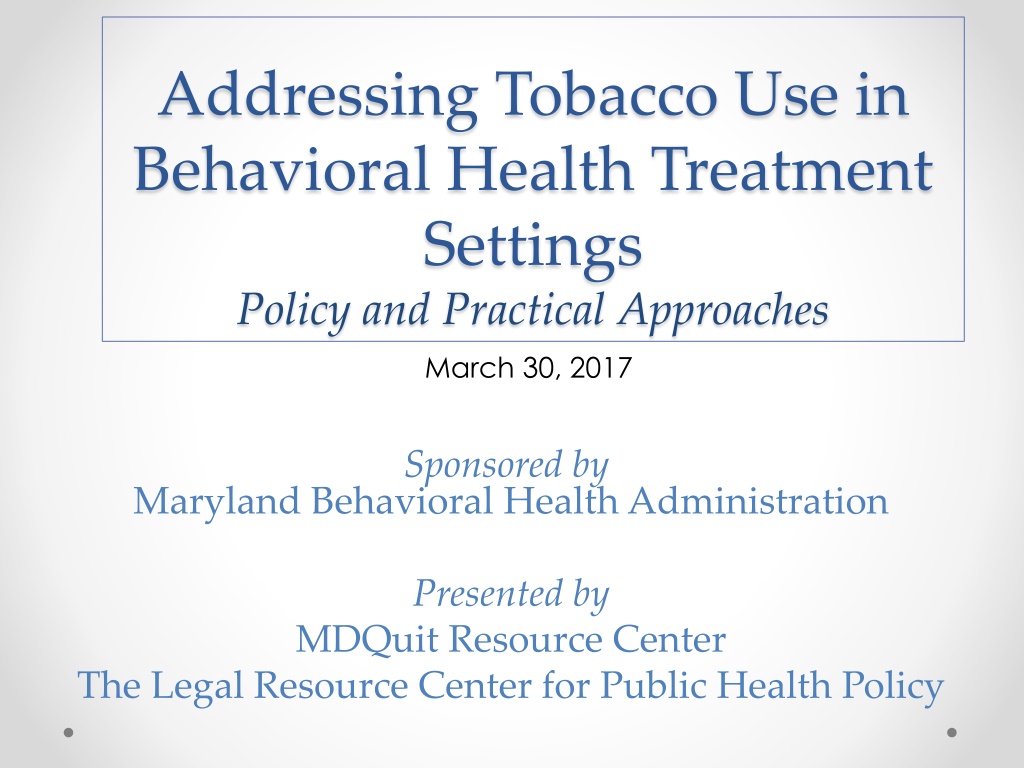

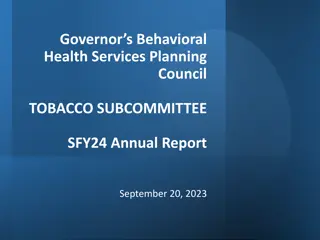
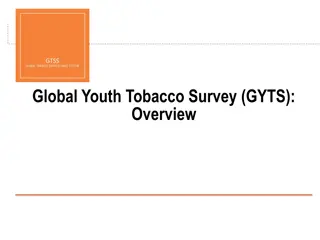
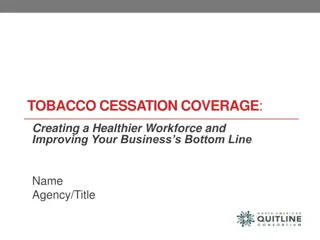
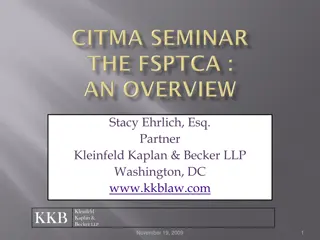
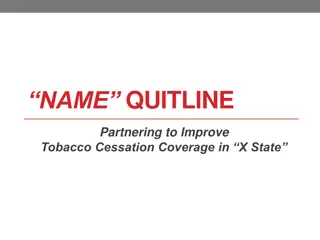

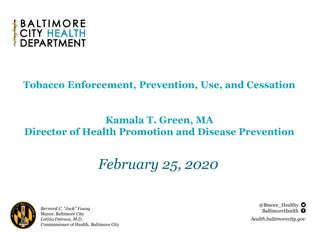
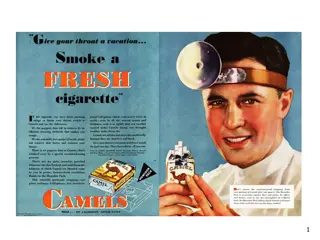
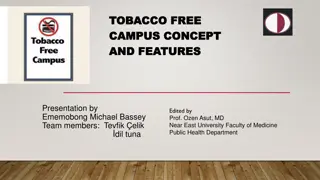
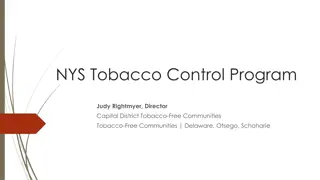
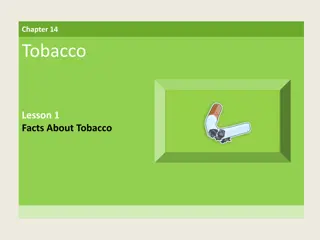
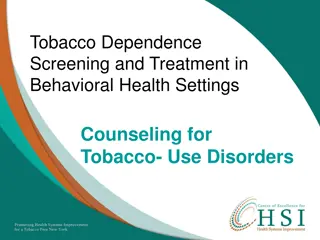
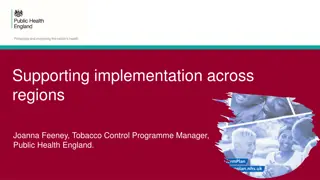
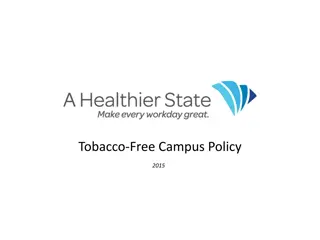

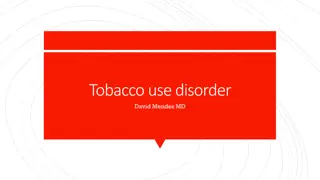
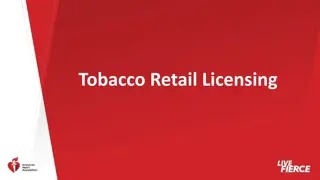

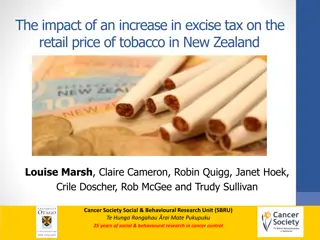
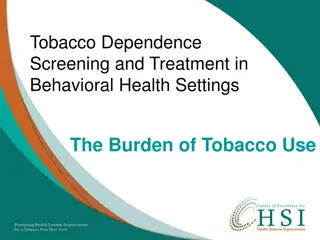
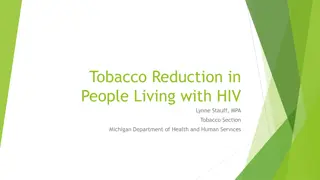
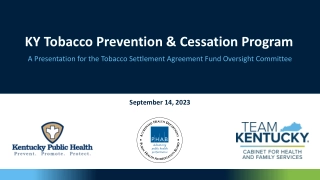
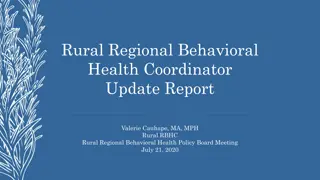
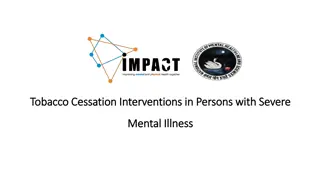
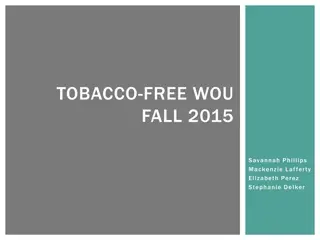
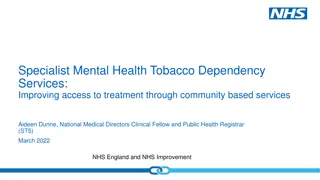

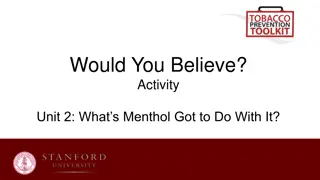
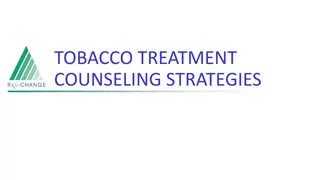
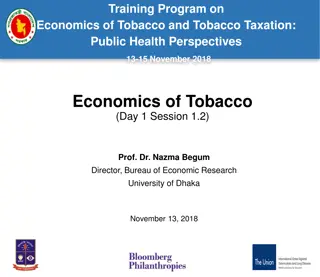
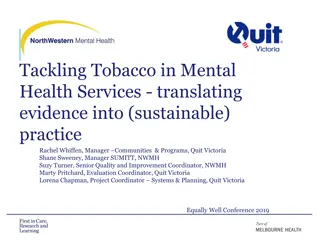
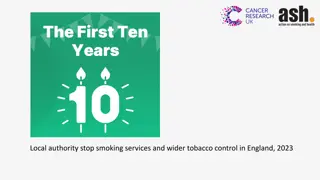
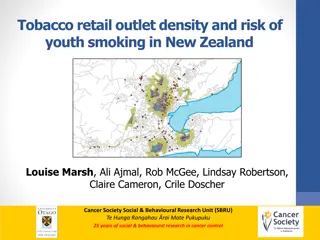
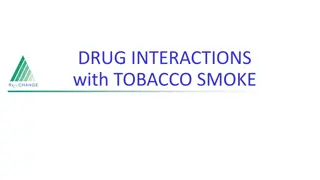
![Protecting Youth Through Tobacco Retail Licensing in [Your County]](/thumb/175307/protecting-youth-through-tobacco-retail-licensing-in-your-county.jpg)
